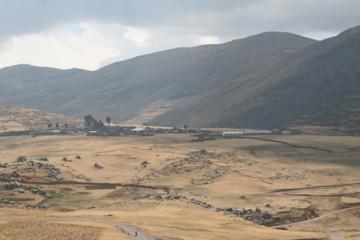
It’s not that I’m unfamiliar with bad roads. Paths that snake along mountain cliffs, falling rocks, mudslides, potholes, roadkill … it’s all part of normal travel in Peru’s Andean region. But my destination, the city of Tambobamba, is not some forgotten outpost – it’s the provincial capital of Cotabambas, just a few hours drive from the massive Las Bambas copper mine, currently under construction.
Usually towns on the way to large mines benefit from having a decent road, especially when that route happens to be the provincial highway. Not Tambobamba. Miners are flown in by company helicopters and the highway remains in sorry disrepair.
Las Bambas is owned by the Swiss company Xstrata, which plans to avoid the dismal road by building a 215 km pipeline to transport concentrates from the mine to facilities in a neighboring state. The mine is expected to be operational in 2014 and the company claims it will produce around 400,000 tons of copper a year, increasing Peru’s output of this metal by 30 percent. (Peru is currently the world’s third largest producer of copper, behind Chile and China).
But there have been protests from local communities who are concerned about contamination and say they’re not receiving the much-promised benefits from the project. In 2008 the Peruvian government fined Xstrata for allegedly leaking harmful substances from exploration drill holes into a nearby community. The news struck fear in the province’s farming communities, which largely survive on subsistence agriculture.
In May of this year, the district of Challhuahuacho, near Las Bambas, declared a strike against the mine, and the company was forced to evacuate its personnel and machines. Leaders complained that only communities close to the mine were receiving benefits and demanded more development projects for the entire region.
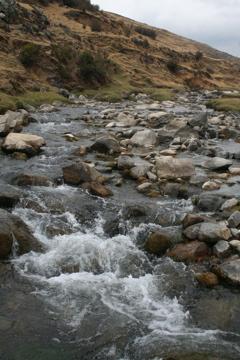
The widespread dissatisfaction with conservative politicians in indigenous and farming communities swept Ollanta Humala – a left-leaning nationalist – to the presidency in July. Now his supporters are waiting for Humala to begin the promised social revolution, but in many parts of the country, patience is wearing thin.
In late September a conflict erupted near Peru’s border with Chile in Tacna. Locals trying to enter a public hearing on an expansion project for a mine operated by the US company Southern Peru were met with violent police repression. Regional leaders threatened to declare a state-wide strike, and in early October Humala’s government was forced to cancel public hearings on the mine. Leaders vowed they would keep protesting until the expansion project is scraped.
At the other end of the country, in the northern mountains of Cajamarca, another conflict is brewing between farmers and Yanacocha, South America’s largest gold mine. Farming groups are protesting the mine’s plan to destroy a sacred mountain and important watershed. The regional government has declared the mountain a protected zone, but the mine, owned by Newmont of Colorado, has vowed to continue the project.
In Peru’s Amazon jungle, native Shuar blocked the Morona River for 10 days, demanding that the oil company Talisman leave their territory. They lifted the blockade when company officials promised to initiate formal negotiations with Shuar leaders.
And at the end of my rough journey, in the small village of Asacasi, just outside Tambobamba, worry about the Las Bambas mine has become a topic of daily conversation. The village has just won a prize for the best management of their water reserves, given by a non-profit organization. In an odd twist, I’ve become part of the prize: their award is a workshop on how to make their own film, and I’ve been asked to lead the training.
The non-profit wants the community to focus on their successful water management plan: a new reservoir, chlorination system and garbage disposal to keep their water clean… But as much as I try to keep them on topic, the threat from the mine creeps into every scene.
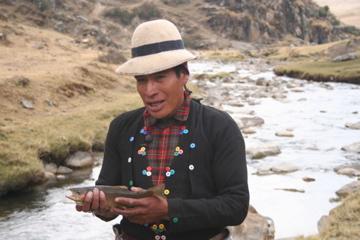
Although he has never worked in film (we began by learning how to turn the camera ON and OFF), Estanislao is a natural-born director. He picks out the biggest trout he can find and instructs the camera operator to use the river as a backdrop while he speaks:
“People in the city often think we peasant farmers don’t know how to take care of our environment,” he says, “but we’ve proved them wrong.” Outsiders are their biggest threat, he says, expressing concern that the Las Bambas mine will bring contamination once it’s up and running. And Las Bambas is just the beginning. Over 54 percent of the state of Apurímac, where Asacasi is located, is under mining concession.
Like most of the region, people in Asacasi still live off the land. This is Peru’s famous ‘altiplano’ region, or ‘high plain’, at over 4,000 meters above sea level in the Andean mountains. At first glance the surroundings seem barren – there are no trees here, just the tall, spikey ‘paja’, or mountain grass and short native bushes. Asacasi sits on a flat, spacious plain, surrounded by imposing mountains with sharp, jagged rocks. You can see the horizon from any direction, a perfect sphere untroubled by buildings or vegetation.
Despite the desolate appearance, the villagers diet would put any North American dedicated to the ‘local food’ movement to shame. Everything is produced in their village: potatoes and herbs from the soil, eggs from their chicken, milk and cheese from their cows, meat from their guinea pigs, sheep and alpaca and, of course, fish, shrimp and frogs from the river.
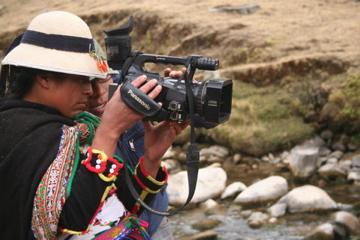
In North America, we have only a few varieties and generally think of a potato as being brown on the outside, white inside. Peru, however, has over 1,000 varieties of native potatoes, each with a distinctive flavor, texture and color: red, brown, grey, yellow and even black ones. Today, I’m served small, round potatoes with a rich, creamy center and larger, oval ones, flakey white on the inside with a dark, crunchy skin.
The main course is trout soup, caught during our morning’s shoot. “What would we do if our fish disappeared?” Gregorio asks. “Now, there’s enough fish to feed the whole village, we don’t have to ration or control it.”
Their fears call to mind the refrain I heard often from people living near Yanacocha, South America’s largest gold mine: “Before the mine, there used to be trout in this river. There used to be frogs.”
Farming and indigenous communities are hopeful that a new law passed by the Humala government will allow them to decide if they want mining, oil or gas projects on their land.
Known as the ‘prior consultation law’, the legislation requires that peasant farming and indigenous communities be consulted before companies begin mega-projects in their territory. The law has generated high expectations in farming communities, but many analysts are more cautious about the law’s potential impact.
Father Marco Arana, a sociologist with 20 years experience defending mining communities, says much depends on the law’s ‘regulation’, which is yet to be written. In Peru, once a law is passed, a policy, or set of rules, is drawn up to determine how the legislation will be implemented. Will the new consultation law mean that Peruvian communities will hold formal referendums before new concessions are awarded on their lands? Or will companies only require consent from local leaders? Will consent even be necessary, or will companies only have to ‘consult’ local communities, without requiring their approval?
The law has also provoked fear in mining circles. Father Arana was attacked recently while traveling to Huancabamba, in Peru’s northern mountains, to mark the anniversary of one of the country’s first referendums on mining. The truck Arana was traveling in was stopped by a handful of locals who told the priest they wanted ‘development’ and were against farming as a viable option. After conversing with the locals, Arana was allowed to continue on his route, but about 30 minutes later the vehicle was shot at and pelted with stones by unidentified gunmen.
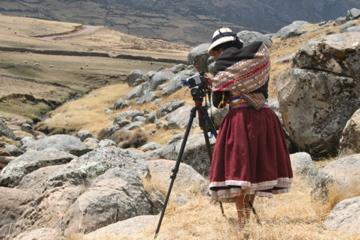 Father Arana is no stranger to trouble. A few years ago he was the focus of a massive espionage ring code-named ‘The Devil Operation’. Every move the priest made over a 3-month period was photographed and videotaped. He and his followers received phone threats and one of his allies – a rural leader opposing a mine expansion project – was assassinated.
Father Arana is no stranger to trouble. A few years ago he was the focus of a massive espionage ring code-named ‘The Devil Operation’. Every move the priest made over a 3-month period was photographed and videotaped. He and his followers received phone threats and one of his allies – a rural leader opposing a mine expansion project – was assassinated.
The stalking and threats frightened Father Arana but he was determined not to become a victim. He and his followers developed a counter-espionage plan and began to spy on the spies – taking photos and video footage of their persecutors. Arana managed to capture one of the spies and got copies of hundreds of reports, photos and video footage. The material became the core of a documentary I made with Arana and the activists called The Devil Operation.
I screened the film in Asacasi, to show villagers the importance of using their new camera and film skills to document human rights abuses. After the screening the community’s mayor, Juan Limaypuma, said he hoped the new ‘prior consultation’ law would put an end to conflicts over mining. He called on Humala’s government to respect international accords signed by Peru from the United Nations and International Labor Organization that protect the rights of indigenous peoples.
Limaypuna says they’re already experiencing ill effects from climate change, like water scarcity, and he fears that new mining projects in the zone will bring further contamination.
Asacasi might be isolated, but her leaders are clearly not ignorant of the outside world. An overwhelming majority of voters in Peru’s southern Andean region voted for Humala, and they now expect him to fulfill election promises to include their needs and rights in a more inclusive and democratic Peru.
If Humala fails, the 246 social conflicts left by Peru’s previous government will resurface. A simple radio announcement by regional leaders can bring thousands of farmers from scattered villages like Asacasi to action, blocking roads, shutting airports and paralyzing economic activity.
Big promises bring great expectations, and Peru’s farming communities will only wait so long before they demand results. The clock is ticking for Humala.
Stephanie Boyd is a journalist and documentary film maker who has been living and working in deepest, darkest Peru for 14 years. She has directed 3 award-winning documentary films: ‘Choropampa, The Price of Gold’ (2002), ‘Tambogrande, Mangos, Murder, Mining’ (2007) and ‘The Devil Operation’ (2010). Her films have screened at over 70 international festivals and been broadcast on the Sundance Channel, CBC Country Canada, Al Jazeera, TeleSur and public television in South Korea, Cuba, Peru and Mexico. Stephanie has written for various publications, including Salon.com, Now magazine, The New Internationalist, Toward Freedom and the Toronto Star.
